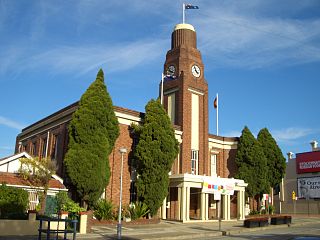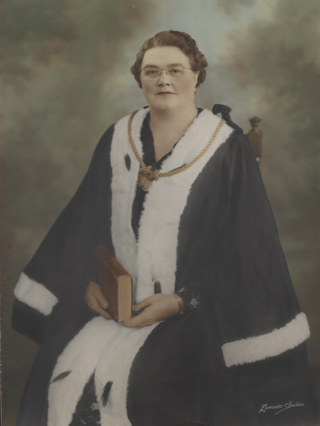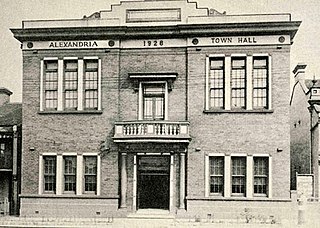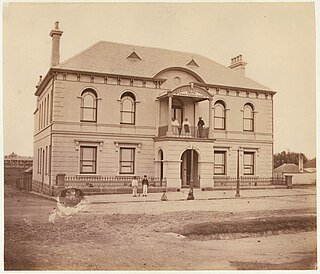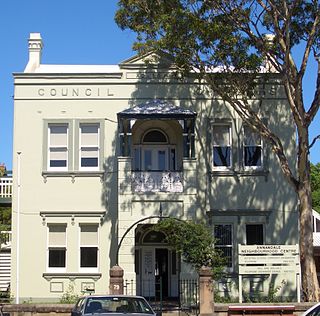Council history and location
The area of Camperdown, bounded by Orphan School Creek and Parramatta Road to the north, Johnstons Creek in the west, and Newtown Road in the east, was first incorporated on 13 November 1862 when a petition of residents was accepted, and was proclaimed by Governor Sir John Young in the Government Gazette . [1] [2] The first election of Aldermen occurred in February 1863. [3] The Aldermen did not elect a chairman for the small council, in contrast to Cook, prior to the enactment of the Municipalities Act, 1867, when the first mayor was elected in February 1868. Under the enactment of The Municipalities Act of 1867, the title of 'Chairman' for the council was changed to be 'Mayor' and both councils also were renamed as the Borough of Camperdown and the Borough of Cook.
Municipality of Cook
The northern part of the Camperdown municipality was originally gazetted as the Municipality of Cook on the same day as Camperdown. [4] However its small size proved highly unsustainable and on 1 May 1869 a petition was presented to the NSW Government which expressed the general opinion that:
"the area of the two Boroughs, if united, could be managed with less expense than at present. That the number of ratepayers in Camperdown is only 138, whilst the rates are barely more than sufficient to defray the working expenses, the improvements having to be effected almost solely by the Government endowment. That the ratepayers are desirous that the two Boroughs should be united and bear the name of Camperdown." [5]
The petition was subsequently accepted by the government and the Borough of Cook was subsumed into the Borough of Camperdown on 19 February 1870. [6]
Municipality of Camperdown
The proclamation subsequently divided the new municipality into three wards: Belmore Ward in the north, Cook Ward in the east and Kingston Ward in the south. [6] However, even with this expansion in the size of the council, it was gradually recognised that the location and size of the municipality was unsustainable and unable to carry out even the most basic of council responsibilities. This was largely because the municipality included large areas occupied by government institutions, such as the Royal Prince Alfred Hospital and the University of Sydney and consequently drew no rates as an income for the council. These institutions also inevitably displaced land that could include the numbers of rate-payers that allowed neighbouring councils to survive and invest in projects that Camperdown could barely afford. [7] [8] The infrastructure demands on the council were significant, including a separate drainage and sewer system and maintenance of major roads such as Missenden Road. [9]
In late 1901 the Camperdown Town Hall on Parramatta Road provided the source of the culmination of decades of financial trouble when the Australian Joint Stock Bank took legal action against the municipality for unpaid debts, which ended in their favour. [10] In 1893 the council had mortgaged the Town Hall with a loan from the Joint Stock Bank. [11] As a consequence, the Town Hall was put up for sale and a receiver was appointed to direct the aldermen on the use and disposal of council monies and assets, which proved a source of great contention. [12] The years of financial troubles also contributed to Camperdown Council's reputation as a rough chamber not a stranger to the brawling of aldermen: "In those days aldermen were not averse to settling a difference of opinion with their fists. A story is told that on one occasion the lights were extinguished and a free fight took place between the aldermen, books and other weapons being freely used." [13]
In late 1903 the council, by now "in a state of hopeless insolvency", was moved to the position of amalgamating the council with one or several of its neighbours. A resolution passed on 27 October invited The Glebe and Newtown councils to discussions over such a proposal, which was firmly rejected by The Glebe. [14] Newtown council were more receptive of the proposal and a report was accepted by Newtown in September 1906. [15] Newtown's proposal was consequent on a significant raising of rates and the establishment of a sinking fund to deal with Camperdown's maintenance backlog and debts. It was this element that proved controversial with Camperdown aldermen, who categorically rejected Newtown's proposal in July 1907 in opposition to the mayor, Thomas Culbert, who had led the negotiations with the previous mayor, Charles Mallett. [16] [17] From 28 December 1906, with the passing of the Local Government Act, 1906, the council underwent a final change, and was again renamed as the "Municipality of Camperdown".
Amalgamation with the City of Sydney

Camperdown council then looked to its more prosperous northern neighbour, the City of Sydney, and a resolution was passed by council in March 1904 which endorsed a proposal that: "in the opinion of this council, it is desirable in the best interests of the Borough of Camperdown to become connected with the City of Sydney by absorption." [9] This resolution set off negotiations with the Sydney City Council which lasted for several years, but, with the council owing around £27,000 (worth roughly $3.8 million AUD in 2015 values) by July 1905, it was clear that the proposal was an inevitable solution, which was made clear in a meeting of ratepayers by the serving mayor and Lord Mayor of Sydney, Allen Taylor. [18] There then followed two referendums of rate-payers, which both gave majorities in favour of accepting the City of Sydney's terms for amalgamation. [9]
The last election of aldermen to Camperdown took place in early 1908, and the last mayor, David Gilpin, was tasked with concluding the negotiations with the City of Sydney, which took the form of a Bill to amend the Sydney Corporation Act 1902. The final meeting of Camperdown council was held on 7 December 1908, with the mayor noting that "I am very pleased to say that the result of the negotiations, in the form of the present Bill, was unanimously agreed to by this council, and has met with the approval of all the ratepayers of Camperdown. The primary object for which we were elected was the extinction of Camperdown as a municipality, and in a few days this will be an accomplished fact." [19] The council officially ceased to exist and was absorbed into the City of Sydney when the Sydney Corporation (Amendment) Act 1908 was passed by the Parliament of New South Wales and assented to on 22 December 1908. [20] A month later, the Sydney Evening News, in reflection of the history of Camperdown council, opined that:
"From any standpoint the new order of things must be welcomed as satisfactory. Under the old regime Camperdown was hopelessly insolvent, many, indeed most, of its streets were almost impassable, and absolutely dangerous to traffic, and there was an ever-growing dissatisfied feeling among the ratepayers that they were getting but a poor return for their municipal taxation." [9]
The Camperdown municipality became the Camperdown Ward of the City of Sydney returning two aldermen. The first elections were held on 8 January 1909, with the two previous mayors of Camperdown returned: David Gilpin and Charles Mallett. [21] [22]




